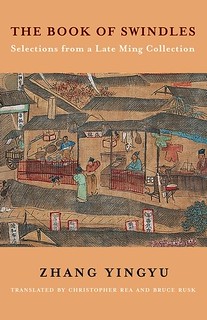
PREV ARTICLE
NEXT ARTICLE
FULL ISSUE
PREV FULL ISSUE
NEW BOOK: THE BOOK OF SWINDLESThe June 2020 issue of Chopmark News edited by Colin Gullberg includes an interview with the coauthor of a recent translation of a 1617 Chinese book offering insight into the use (and counterfeiting of) silver in daily commerce in the late-Ming and early-Qing periods. With permission, here is an excerpt from the interview. -Editor
In this issue, I interview Dr. Bruce Rusk. Dr. Rusk is Associate Professor of Asian Studies at the University of British Colombia in Vancouver, Canada. His focus is on late Ming, early Qing cultural history. I interviewed him in Taipei where he is a visiting researcher at Taiwan's Academia Sinica, Taiwan's top research center. You can read about Professor Rusk's information here. CG - Colin Gullberg BR - Bruce Rusk CG: Thank you so much for talking to me today. First let me tell my readers what your area of exper- tise is. You are interested in what might be called crime literature from China in the late-Ming and early-Qing periods [1500 and 1600s]. You, along with another researcher, Christopher Rea, translated an unusual book, The Book of Swindles [杜騙新書] published 1617 by Zhang Yingyu [張應俞]. Much of the book describes crime and how to avoid being a victim of fraud, forgery and theft. Many of the stories involve silver. The book actually predates chopping in China but since it deals with silver and how silver was used in China in the 1500s and 1600s I thought Chopmark News readers would be interested in your research. How did you get interested in this area of research? BR: I'm interested in the ways people authenticated texts and material objects in Ming and Qing China. It's a fascinating period to study as there were many important changes going on. Printing was spreading, a new class of rich people had appeared and they wanted to know how to assess the quality and genuineness of items like silver to avoid being cheated. CG: The book is made up of a large number of very short stories describing various crimes. Are the stories in the book fictional or essentially true? BR: All are fiction but a few are tied to real people. It's impossible to know if some version of the scams actually happened but many are quite believable. CG: Who was the intended reader of this book? Travelling merchants? BR: Merchants are the main readers the author addresses, so they were probably the main audience when it was first published. The stories usually explain an event, like how a merchant was cheated with fake silver ingots and tell the reader what to watch out for to avoid having the same thing happen to them. CG: You also wrote “The handful of surviving assaying manuals must represent only a fraction, at least in terms of editions and copies, of a larger corpus. They were ephemera, not the sort of book that elite collectors, even if they happened to own one, would catalogue or preserve, and often such documents survive only because they were copied into other books. One of the earliest examples comes from The Book of Swindles (1617) by Zhang Yingyu.” where he says, “In the autumn of 1611 I came across a booklet in a book shop that explains very clearly how to distinguish between genuine and fake silver. I have copied a selection below so that gentlemen out in the world might see it and clearly identify it at first sight.” Was this an early shroff handbook and did the shroff handbooks have a hand in a new form of Chinese literature? BR: I think you could just as well call it a ‘counterfeiter's manual,' since it talks about how to make fake silver as much as it tells you how to spot it. It was before Spanish coins had arrived in China but silver bars had started coming in from Mexico and Peru, as well as Japan, in volume.
For more information, or to order, see:
The issue has a number of interesting and useful articles. Topics include chopmarks on ancient coins and paper money, and detailed looks at coins from member collections and recent auction sales. -Editor
For more information on Chopmark News, or to subscribe, contact Colin Gullberg at:
THE BOOK BAZARREWayne Homren, Editor The Numismatic Bibliomania Society is a non-profit organization promoting numismatic literature. See our web site at coinbooks.org. To submit items for publication in The E-Sylum, write to the Editor at this address: whomren@gmail.com To subscribe go to: https://my.binhost.com/lists/listinfo/esylum All Rights Reserved. NBS Home Page Contact the NBS webmaster 
|
